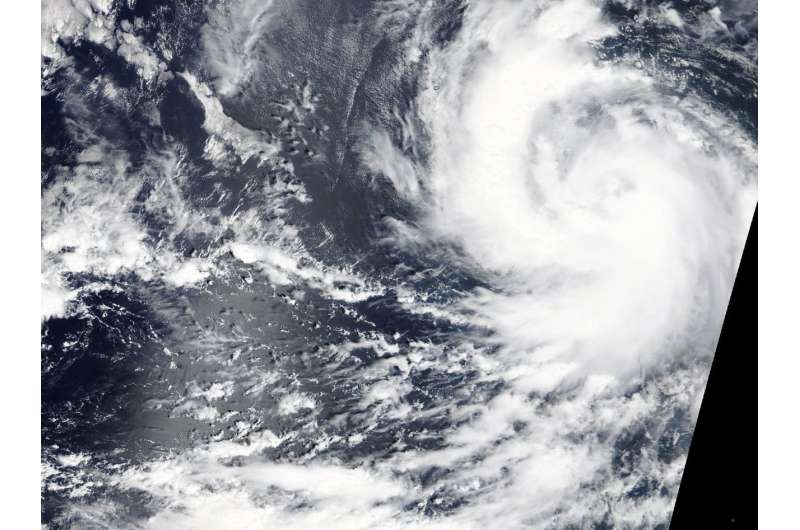NASA's close up of Hurricane Rosa shows hint of an eye

On Sept. 26 at 4:30 p.m. EDT (1630 UTC), the MODIS instrument aboard NASA's Terra satellite captured a visible image of Hurricane Rosa. Credit: NASA Worldview, Earth Observing System Data and Information System (EOSDIS)
On Sept. 26 at 4:30 p.m. EDT (1630 UTC), the Moderate Resolution Imaging Spectroradiometer or MODIS instrument aboard NASA's Terra satellite captured a visible image of Rosa. The image showed what appears to be a cloud filled-eye surrounded by bands of thunderstorms. Two thick bands of thunderstorms were wrapping into the center from the west and south.
The National Hurricane Center or NHC noted "Conventional satellite imagery show a large area of cold cloud tops near the center, and there is a hint of an eye in the first-light visible images. Microwave imagery indicates that the eye structure underneath the overcast has become better defined, with less evidence of dry air entrainment than seen yesterday."
At 11 a.m. EDT (1500 UTC), NHC reported the center of Hurricane Rosa was located near latitude 17.2 degrees north and longitude 115.4 degrees west. Rosa is far enough away from land so no coastal warnings or watches are in effect. Rosa is about 530 miles (855 km) southwest of the southern tip of Baja California, Mexico.
Rosa is moving toward the west near 12 mph (19 kph). This general motion is expected to continue through tonight, with a slower motion toward the west-northwest on Friday and toward the northwest Friday night and Saturday. Maximum sustained winds have increased to near 105 mph (165 kph) with higher gusts. Additional strengthening is forecast through Friday, and Rosa is expected to become a major hurricane by Thursday, Sept. 27. The hurricane is expected to begin weakening on Saturday.
Hurricane-force winds extend outward up to 30 miles (45 km) from the center and tropical-storm-force winds extend outward up to 105 miles (165 km).
NHC expects Rosa to take a turn back to the east and weaken. It is expected to make landfall in the northwestern Baja California Peninsula sometime on Oct. 2.
Provided by NASA's Goddard Space Flight Center





















